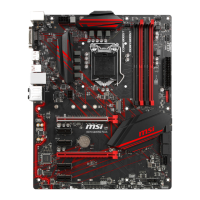3-9
BIOS Setup
Fast Boot
Setting the item to [Enabled] allows the system to boot within 5 seconds since it will
skip some check items. Setting options: [Enabled], [Disabled].
Quick Power On Self Test
Select Enabled to reduce the amount of time required to run the power-on self-test
(POST). A quick POST skips certain steps. We recommend that you normally disable
quick POST. Better to find a problem during POST than lose data during your work.
Boot Up Floppy Seek
When [Enabled], the BIOS tests (seeks) floppy drives to determine whether they
have 40 or 80 tracks. Only 360-KB floppy drives have 40 tracks; drives with 720 KB,
1.2 MB, and 1.44 MB capacity all have 80 tracks. Because very few modern PCs
have 40-track floppy drives, we recommend that you set this field to [Disabled] to
save time.
Boot Up NumLock Status
This setting is to set the Num Lock status when the system is powered on. Setting to
[On] will turn on the Num Lock key when the system is powered on. Setting to [Off]
will allow users to use the arrow keys on the numeric keypad. Setting options: [On],
[Off].
Gate A20 Option
This item is to set the Gate A20 status. A20 refers to the first 64KB of extended
memory. When the default value [Fast] is selected, the Gate A20 is controlled by
Port92 or chipset specific method resulting in faster system performance. When
[Normal] is selected, A20 is controlled by a keyboard controller or chipset hardware.
Typematic Rate Setting
This item is used to enable or disable the typematic rate setting including Typematic
Rate & Typematic Delay.
Typematic Rate (Chars/Sec)
After Typematic Rate Setting is enabled, this item allows you to set the rate (characters/
second) at which the keys are accelerated. Settings: [6], [8], [10], [12], [15], [20], [24],
[30].
MSI Reminds You...
Enabling the functionality of Hyper-Threading Technology for your com-
puter system requires ALL of the following platform Components:
* CPU: An Intel
®
Pentium
®
4 Processor with HT Technology;
* Chipset: An Intel
®
Chipset that supports HT Technology;
* BIOS: A BIOS that supports HT Technology and has it enabled;
* OS: An operating system that supports HT Technology.
For more information on Hyper-threading Technology, go to:
www.intel.com/info/hyperthreading

